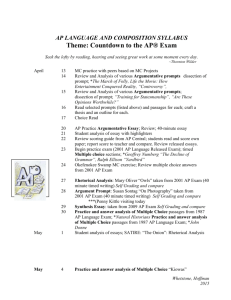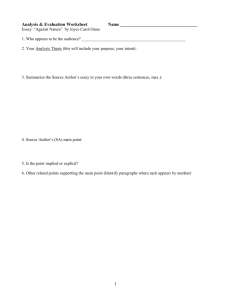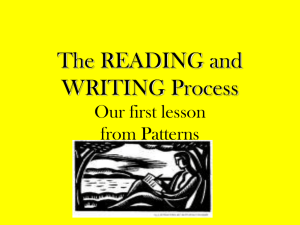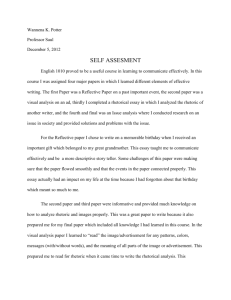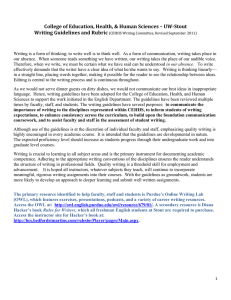AP Language and Composition Course Syllabus 2012
advertisement
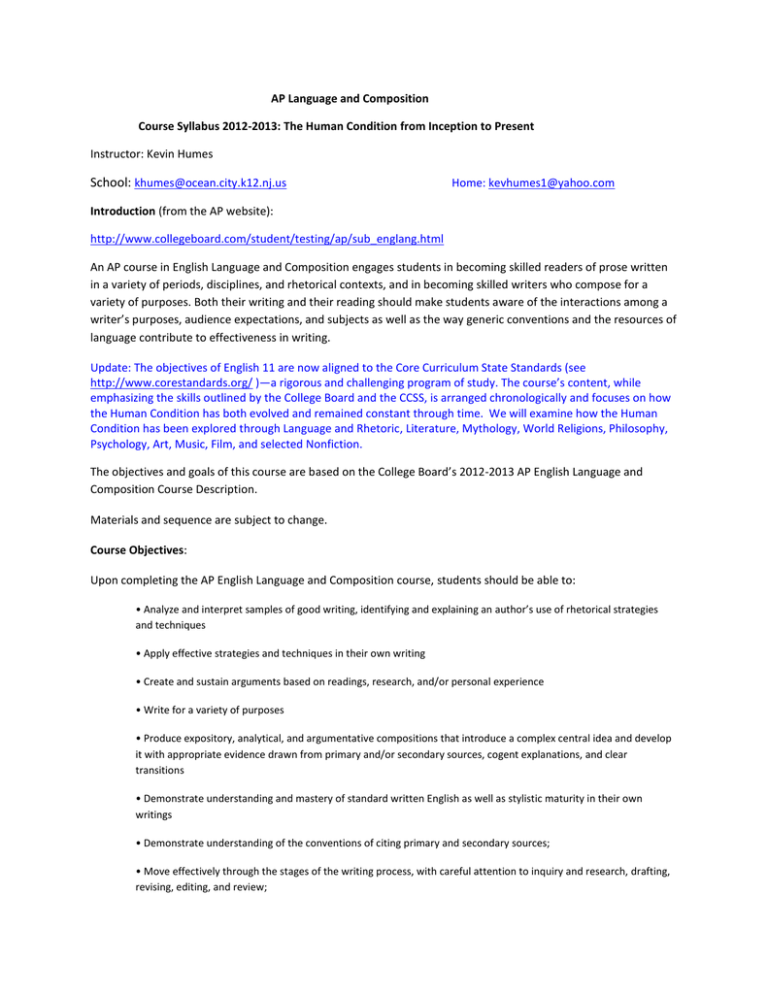
AP Language and Composition Course Syllabus 2012-2013: The Human Condition from Inception to Present Instructor: Kevin Humes School: khumes@ocean.city.k12.nj.us Home: kevhumes1@yahoo.com Introduction (from the AP website): http://www.collegeboard.com/student/testing/ap/sub_englang.html An AP course in English Language and Composition engages students in becoming skilled readers of prose written in a variety of periods, disciplines, and rhetorical contexts, and in becoming skilled writers who compose for a variety of purposes. Both their writing and their reading should make students aware of the interactions among a writer’s purposes, audience expectations, and subjects as well as the way generic conventions and the resources of language contribute to effectiveness in writing. Update: The objectives of English 11 are now aligned to the Core Curriculum State Standards (see http://www.corestandards.org/ )—a rigorous and challenging program of study. The course’s content, while emphasizing the skills outlined by the College Board and the CCSS, is arranged chronologically and focuses on how the Human Condition has both evolved and remained constant through time. We will examine how the Human Condition has been explored through Language and Rhetoric, Literature, Mythology, World Religions, Philosophy, Psychology, Art, Music, Film, and selected Nonfiction. The objectives and goals of this course are based on the College Board’s 2012-2013 AP English Language and Composition Course Description. Materials and sequence are subject to change. Course Objectives: Upon completing the AP English Language and Composition course, students should be able to: • Analyze and interpret samples of good writing, identifying and explaining an author’s use of rhetorical strategies and techniques • Apply effective strategies and techniques in their own writing • Create and sustain arguments based on readings, research, and/or personal experience • Write for a variety of purposes • Produce expository, analytical, and argumentative compositions that introduce a complex central idea and develop it with appropriate evidence drawn from primary and/or secondary sources, cogent explanations, and clear transitions • Demonstrate understanding and mastery of standard written English as well as stylistic maturity in their own writings • Demonstrate understanding of the conventions of citing primary and secondary sources; • Move effectively through the stages of the writing process, with careful attention to inquiry and research, drafting, revising, editing, and review; • Write thoughtfully about their own process of composition; • Revise a work to make it suitable for a different audience • Analyze image as text; and • Evaluate and incorporate reference documents into researched papers. Organization The AP Language and Composition course is arranged thematically; with each unit focusing on developing the skills outlined above. The units will begin with a focus on diction and syntax and move toward increasingly complex reading and writing tasks. Unit One: Writing and the Writer a. b. c. d. e. f. g. h. II. Introduction to course: syllabus/ website/ terms/ exam Close reading / DIDLS (Diction, Imagery, Details, Language, Syntax) i. Blood Meridian passages (opening paragraph and Comanche attack sequence) ii. Passage Analysis essay RFW: 3-7; 16-27; 59-63; 97-107; 135-141; 169-178 Essay Packet: i. Prose, Francine, Reading Like a Writer ii. Roberts, Paul “How to Say Nothing in Five Hundred Words” iii. Lutz, William “The World of Doublespeak” iv. Orwell, George “Politics and the English Language” v. Ferlinghetti, Lawrence. “Constantly Risking Absurdity” vi. Moore, Lorrie “How to Become a Writer” vii. Handout: Thought-terminating clichés Annotate and respond to each. Pick most relevant or illuminating passages from at least three and compose a typed Synthesis Essay on writing and the writer. Film: The Persuaders (Excerpt) Sample AP reading section (diagnostic) Interrelationship of form and content i. Forche, Carolyn “The Colonel ii. Machan, Kathryn Howd "Hazel Tells LaVerne" iii. O’Brien, Tim, The Things They Carried a). Literature circle b). Timed essay on form and content Unit Two: Rhetoric and Argument a. Introduction to SOAPStone (subject, occasion, audience, purpose, speaker, tone) and rhetorical modes (arrangement for purpose) i. RFW: 195-213; 251-255; 296-298; 332-336; 369-373; 412-418; 454-457; 497-501; 550556 ii. Theodore Roosevelt, from The Winning of the West, Vol. 1, New York, 1910, iii. Report of the Commissioner of Indian Affairs (excerpt), Washington, 1873 iv. Chief Red Cloud’s speech in New York on July 16, 1870 v. Llosa, Mario Vargas, "Why Literature?" b. III. vi. Selected essays for analysis vii. Essay: Rhetorical Analysis Argument assignments i. RFW intro: (569-575) ii. Iclaim CD ROM iii. Rhetoric test iv. Vidal, Gore, “Drugs” (from RFW 361) v. Snoop Dogg ;’The Doggfather” vi. Kondrake, Mort, “Don’t Legalize Drugs” (RFW 364) a.) Essay: Compare/ contrast rhetorical strategies Unit Three: Beginnings: Introduction to Archetypes, Myths, and Fairy Tales Note to parents and students: This unit contains mythical and Biblical passages which I intend to explore solely in a literary context. I am neither promoting nor dissuading any doctrine or belief whatsoever. In addition to appearing frequently in literature as allusion, these passages have had an enormous impact on Western Civilization and literate citizens should at least have a passing knowledge of them. We will examine what themes, implications, and issues each presents and how they compare and contrast with other cultures. a. b. c. d. e. f. g. h. i. j. Campbell/ Jung handouts (packet and introduction to Hero with a Thousand Faces) Jung Typology test Hamilton, Edith. Mythology Icarus/ other myth poems (poem packet) Selected world myths (Norse, Egyptian, African, Native American, etc) Plato, “Allegory of the Cave” Sophocles. Oedipus Tyrannus Biblical Passages i. “The Creation and Fall” ii. “The Flood” iii. “Job” iv. “Sermon on the Mount” v. “The Crucifixion” Cinderella (three versions) Assessment: original myth? Alternative treatment? IV. Unit Four: Changes: Middle Ages / Renaissance/ Industrial Revolution a. Beowulf (excerpts) b. Chaucer, Geoffery. Canterbury Tales (Pardoner’s Tale, Wife of Bath) c. Shakespeare, William. Hamlet, Midsummer Night’s Dream, or Henry IV d. Machiavelli, Niccolo, “The Morals of The Prince” (from The Prince) e. Marx, Karl, The Communist Manifesto (excerpt) f. Selected Enlightenment passages V. Unit Five: Modernity/ Postmodernity a. Freud, Sigmund, On the Interpretation of Dreams (excerpt) b. Kaczinsky, Theodore, Industrial Society and its Future (excerpt) c. Postman, Neil. “The Medium is the Metaphor” d. “Is Google Making Us Stoopid?” e. Contemporary articles f. Selected Postmodern texts may include: g. i. Heller, Joseph. Catch-22 ii. Atwood, Margaret. The Handmaid’s Tale iii. Morrison, Toni. Song Of Solomon iv. Gardner, John. Grendel v. Ames, Marc. Going Postal vi. Vonnegut, Kurt. Player Piano or Rosewater vii. McCarthy, Cormac. The Road viii. Chomsky, Noam. Media Control Original narrative Unit Six: AP Exam Prep h. Review of terms and concepts of previous seven units. i. Test taking techniques, prompt analysis, essay scoring and test simulation Unit Seven: The Contemporary World i. Choices from the above list ii. Contemporary essays, news items and literature iii. Film analysis Grading Policy: I use a point system, as I’ve found it to be both equitable and flexible. As a general rule (but subject to change give the size or time an assignment requires), assignments are worth the following point values: Homework and classwork: 10 points Quizzes: 30 points Tests and essays: 100 points Grades are calculated by earned points divided by possible points. All other school policies apply as per the Student Handbook.
